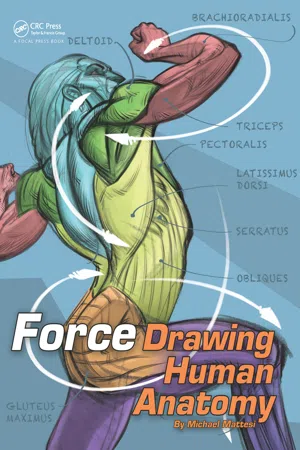
- 313 pages
- English
- ePUB (mobile friendly)
- Available on iOS & Android
eBook - ePub
FORCE: Drawing Human Anatomy
About this book
The newest book in Michael Mattesi's Force Drawing series takes movement to the next level. Force: Drawing Human Anatomy, explores the different facets of motion and the human body. As opposed to the memorization technique, Mattesi stresses the function of each body part and how gravity relative to different poses affects the aesthetics and form of muscle. The chapters are divided by the different parts of the body, thus allowing the reader to concentrate on mastery one body part at a time. Color coded images detail each muscle and their different angles. Special consideration is given to anatomy for animation, allowing the reader to create a character that is anatomically accurate in both stillness and motion.
Key Features
- Detailed visual instruction includes colourful, step-by-step diagrams that allow you to easily follow the construction of an anatomically correct figure.
- Clearly organized and color coded per regions of the body's anatomy, a clarity of design for better reader understanding.
- Learn how anatomy is drawn and defined by the function of a pose.
- Visit the companion website for drawing demonstrations and further resources on anatomy.
Frequently asked questions
Yes, you can cancel anytime from the Subscription tab in your account settings on the Perlego website. Your subscription will stay active until the end of your current billing period. Learn how to cancel your subscription.
At the moment all of our mobile-responsive ePub books are available to download via the app. Most of our PDFs are also available to download and we're working on making the final remaining ones downloadable now. Learn more here.
Perlego offers two plans: Essential and Complete
- Essential is ideal for learners and professionals who enjoy exploring a wide range of subjects. Access the Essential Library with 800,000+ trusted titles and best-sellers across business, personal growth, and the humanities. Includes unlimited reading time and Standard Read Aloud voice.
- Complete: Perfect for advanced learners and researchers needing full, unrestricted access. Unlock 1.4M+ books across hundreds of subjects, including academic and specialized titles. The Complete Plan also includes advanced features like Premium Read Aloud and Research Assistant.
We are an online textbook subscription service, where you can get access to an entire online library for less than the price of a single book per month. With over 1 million books across 1000+ topics, we’ve got you covered! Learn more here.
Look out for the read-aloud symbol on your next book to see if you can listen to it. The read-aloud tool reads text aloud for you, highlighting the text as it is being read. You can pause it, speed it up and slow it down. Learn more here.
Yes! You can use the Perlego app on both iOS or Android devices to read anytime, anywhere — even offline. Perfect for commutes or when you’re on the go.
Please note we cannot support devices running on iOS 13 and Android 7 or earlier. Learn more about using the app.
Please note we cannot support devices running on iOS 13 and Android 7 or earlier. Learn more about using the app.
Yes, you can access FORCE: Drawing Human Anatomy by Mike Mattesi in PDF and/or ePUB format, as well as other popular books in Computer Science & Programming Games. We have over one million books available in our catalogue for you to explore.
Information
Chapter 1
The Power of FORCE
FORCE is a challenging topic to teach. It is far less obvious to witness than measurement and proportion. Those topics are also, at times, difficult to instruct since they demand the visual clarity of the artist for the awareness to occur. FORCE is invisible. It is not tattooed on the body. I have experienced over the years that FORCE is more quickly understood if, at first, the artist draws striving for the FORCE ″experience.″ Drawing with the line that I will present to you conveys a physical activity. You must ″feel″ FORCE running through the figure by mimicking and understanding rhythmic FORCES in the body. In the first few chapters, I will cover the basics of FORCE. For a deeper understanding of the theory, read FORCE: Dynamic Life Drawing, 10th Anniversary Edition (2017).
This anniversary edition of FORCE has video tutorials that present what the FORCE experience of drawing looks like as you see me create them.
At the time of publication of this book, I have been teaching drawing for 26 years. In those years I experimented alongside the students I taught on what types of marks work best for FORCE and why. I observed and became aware of students’ habits when they entered my classes and investigated why they had those habits and how to change them. Some students changed quickly, others took much longer...some never changed or grew at all.
If you are an instructor using this book for your class, don’t judge. In my early years of teaching, I would have my own thoughts on who I thought would excel quickly and who would never get it early in a term, and at times I was extremely surprised by the students’ results. Stay open to each student; inspire them to learn! You will be amazed at who can take off like a rocket with a bit of focus and encouragement.

Since we are DRAWING to learn, we need to use a line. The image above presents two types of drawing approaches shown in black that I see commonly used. The black lines in the left example come from a fear of drawing. The concern to get it right, committing, and being accurate stifle the artist. The sketchy, black line example on the right is the opposite approach. A more careless attitude is taken; a lack of responsibility to the model comes into play...or does it? Sometimes, this artist is actually the artist on the left in disguise, and is so terrified to draw that the fear is overwhelming, so they resort to the careless approach.

This is it, folks, THE FORCE line! Everything in this book and all my other books is built on this stroke because the stroke itself represents the IDEA of FORCE. It appears to be so simple and inconspicuous, yet it is so powerful. Let’s look at it more closely. Notice the following:
- It tapers at the beginning and end of the stroke. What does that mean? I drew it while my hand was in motion.
- The line is thicker at its apex. I pressed hardest at that moment in time, not before or after that moment.
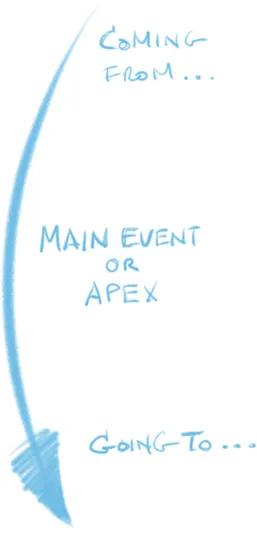
Let me share with you the thoughts that occur for me while drawing this amazing line. The FORCE line above is called a DIRECTIONAL FORCE line.
It has three components:
- Coming from...
- Main event/apex
- Going to...
As I mentioned prior, the line is an idea, FORCE. Within that idea are the three components you will think about while drawing it. The blue color you see above is the color I will use throughout the rest of the book to present Directional FORCE.

There is a second FORCE you need to think about when drawing a Directional FORCE, and that is APPLIED FORCE. It will always be represented by this orange color. This second FORCE pushes upon the Directional FORCE at its apex, causing the amount of curvature to appear. Where did this Applied FORCE come from?
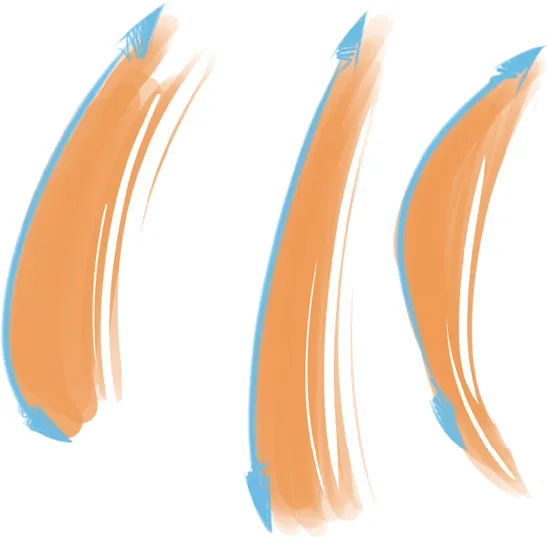
Applied FORCE is the mass of the body pushing against the edge of the form that you see at that specific moment in time. Above are varied examples of Applied FORCE presenting different amounts of Applied FORCE.
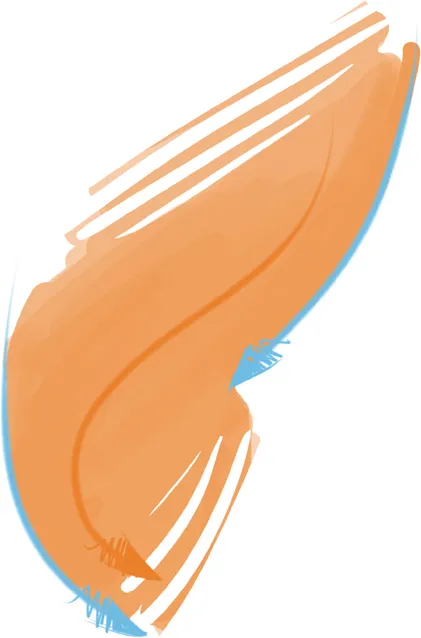
Applied FORCE is a prior Directional FORCE applying itself to the Directional FORCE you are drawing at the moment. This can be seen with the orange arrow connecting the two Directional FORCES. Once you have two Directional FORCES and one Applied FORCE connecting them, you have one rhythm.
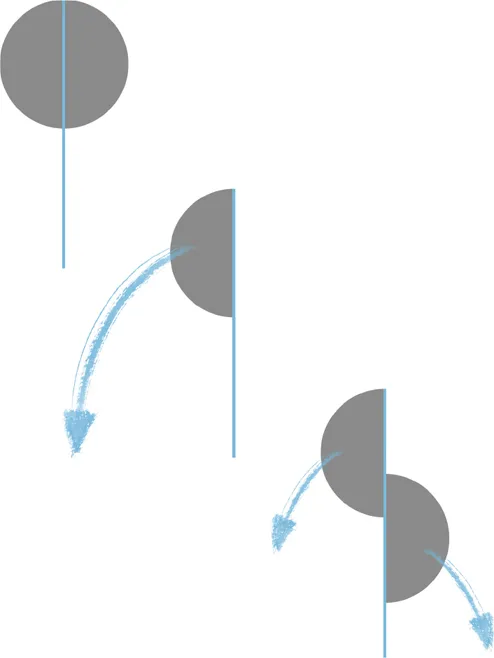
Rhythm creates balance. The human figure is not only made of FORCE but also form, otherwise known as anatomy. The top-left image presents a balanced, vertical line since the sphere at the top is perfectly centered on the vertical axis. The center image shows how a form, the hemisphere, when on one side of the vertical blue line, wants to fall to the left side. The downward blue arrow shows how gravity would pull the hemisphere down in an arc toward the ground. The bottom-right image offsets the hemispheres, retaining balance yet creating rhythm!
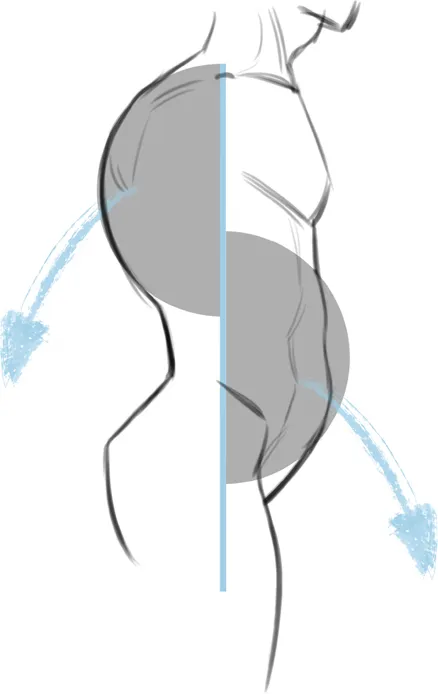
Here is the abstract of form on our centerline of balance superimposed with a figure drawing. See how the upper back balances with the abdomen.
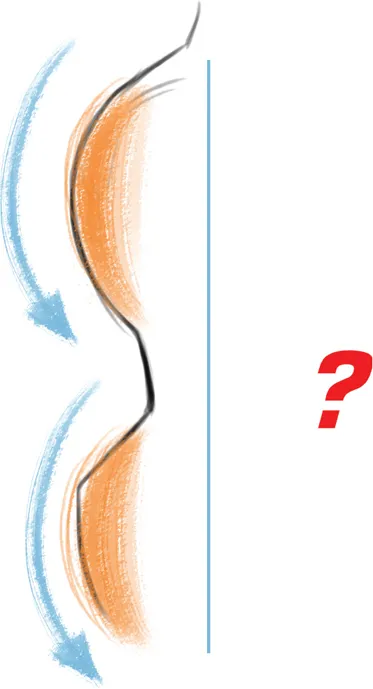
When you define more than one mass on only one side of the centerline of balance, the figure is immediately out of balance. If the time period to draw was over at this time, the drawing would be out of balance. I call this issue the ″bunny hop″ since you end up with a double bounce or a hop. As soon as you see one FORCE, know it will lead you across the figure to create balance.

Here is the figure without the mass shapes. See how connecting the first two FORCES immediately create balance and rhythm! It is the relationship between these two Directional FORCES that creates a rhythm.
PROFILE VIEW TEMPLATE

Above is a rhythm template of the figure in profile. See how FORCE bounces from side to side across the centerline of balance.
These distances and regions of the FORCE rhythms determine the anatomical breakdown of the book’s chapters.
FRONT VIEW TEMPLATE

Here is the template for the front of the figure. You will notice that most of the upper body is symmetrical. It is in the limbs that we find some rhythm. This is due to the function of the muscles. In the upper body, all of the opposing muscles’ functions of the figure are mostly found in the relationships between the front and back muscles of the body. That is why, in the side view, we find much rhythm. The rear view of the figure contains the same rhythms as the front.
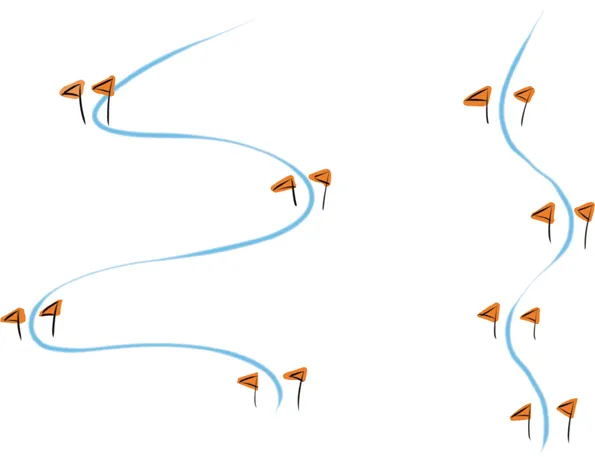
One analogy I often use to understand the feeling or experience of drawing with FORCE is skiing. Gravity pulls you down the mountain. Your body wants to slide in a straight line down to the bottom, but you angle your skis to the side, and you change your body’s trajectory. This causes a lot of FORCE on the downhill side of your skis. Once you travel to the edge of the trail, you push or jump into the new trajectory, pointed toward the other side of the slope. Bouncing and sliding back and forth down the slippery, snow-covered surface of the mountain is similar to the drawing experience of FORCE.
The drawings above present the di...
Table of contents
- Cover
- Title Page
- Copyright Page
- Dedication
- Contents
- Special Thanks
- SPreface
- Key Concepts
- Chapter 1: The Power of FORCE
- Chapter 2: Mass and FORCEFUL Form
- Chapter 3: FORCE Shape
- Chapter 4: The Skeleton: Framework for the Figure
- Chapter 5: How This Book Functions
- Chapter 6: Head, Neck, Upper Back
- Chapter 7: Chest, Shoulders, Blades
- Chapter 8: Arms, Hands
- Chapter 9: Abs, Obliques, Serratus Lats
- Chapter 10: Pelvis, TFL, Glutes
- Chapter 11: Thighs, Hamstrings
- Chapter 12: Knees, Calves, Feet
- Chapter 13: Closing Thoughts
- Index